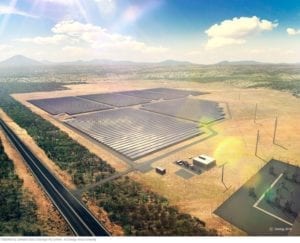BHP, Mitsubishi Partner on Emissions Reduction Technologies
Credit to Author: Darrell Proctor| Date: Mon, 29 Jul 2019 17:04:45 +0000
BHP and Mitsubishi Development Pty (MDP) in late June signed a memorandum of understanding for joint research, development, and deployment of greenhouse gas emissions reduction technologies in several countries, including projects with battery storage, solar, and carbon capture and storage (CCS). The agreement, signed in Tokyo, Japan, on June 20, also calls for research into emissions reductions from the lifecycle use of marketed products.
“BHP is committed to accelerating the development of emerging technologies that have the potential to achieve material reductions in greenhouse gas emissions,” said Andrew Mackenzie, BHP’s CEO, in a statement. “Our new collaboration with Mitsubishi Development demonstrates the important role the private sector can play in bringing these technologies to market. Both companies are committed to emissions reductions in a range of industries … our Japanese partners and customers are critical to the development of new technologies and approaches to emissions reductions that stand to benefit countries across the globe.”
BHP has several investments in technologies designed to lower emissions, including trials of light electric vehicles powered by lithium-ion batteries in BHP’s Olympic Dam underground mine fleet of light vehicles, in South Australia. The company also participates in the Lakeland Battery Storage and Solar project, which features a 13-MW solar PV installation with battery storage of 5 MW per hour in regional Queensland, Australia, built by Conergy (Figure 1). Lakeland is the first large-scale solar and battery storage project to be connected to the grid in Australia, and is considered a test case for deliberate “islanding” of power generation, where a section of the grid continues to provide power while disconnected from the main grid.

1. The Lakeland Battery Storage and Solar project in Australia is among the many power generation projects in which BHP has a stake. The company is now working with Mitsubishi Development Pty on initiatives aimed at emissions reductions. Courtesy: Conergy
BHP also is involved in a three-year, $7.37 million partnership with Peking University to study barriers to CCS deployment in the industrial sector. BHP has invested about $15.2 million to establish the SaskPower CCS Knowledge Centre at the Boundary Dam project in Canada, the world’s first commercial-scale CCS process on a coal-fired power plant, and the 2015 POWER magazine Plant of the Year.
BHP also has a $6 million equity investment in Canadian-based Carbon Engineering Ltd., which is leading the development of direct air capture, a technology being designed to deliver large-scale negative emissions by removing carbon dioxide from the atmosphere.
MDP Managing Director and CEO, Sadahiko Haneji, in a statement said the agreement with BHP shows that “Mitsubishi Corporation Group, and therefore MDP, is committed to simultaneously generating economic value, environmental value and societal value through all business activities it conducts.
“In line with this principle and guided by commitment to corporate social responsibility, as well as global climate targets, MDP is enhancing its efforts to generate further environmental value, to help society transition to a low carbon future. We are confident that this partnership with BHP will help us to achieve our goal, as well as contribute to the sustainable future of our local and global communities,” Haneji said.
The BHP-MDP partnership is part of BHP’s global program of advancing low-emissions technologies. “At BHP, we work with customers, suppliers and parties along our value chain to influence emissions reductions across the full lifecycle of our products,” Mackenzie said. “As well as investments in emerging technologies, we set greenhouse gas emissions reduction targets for our operations, we build the resilience of our operations and communities to the physical impacts of climate change, and we work across sectors to strengthen the global policy and market response.”
The BHP Mitsubishi Alliance (BMA), jointly owned by BHP and MDP, is Australia’s largest coal producer. BMA operates seven Bowen Basin mines and also owns and operates the Hay Point coal terminal near Mackay, Australia.
—Darrell Proctor is a POWER associate editor.
The post BHP, Mitsubishi Partner on Emissions Reduction Technologies appeared first on POWER Magazine.